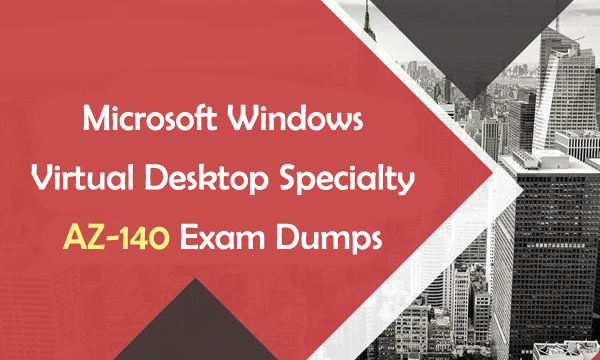Configuring and Operating Windows Virtual Desktop on Microsoft Azure AZ-140 exam is a required test for Microsoft Certified: Windows Virtual Desktop Specialty certification. Candidates for the Microsoft certification are Microsoft Azure administrators with subject matter expertise in planning, delivering, and managing virtual desktop experiences and remote apps, for any device, on Azure. We just cracked the latest Microsoft Windows Virtual Desktop Specialty AZ-140 exam dumps, which will be helpful in the preparation.

Microsoft Certification AZ-140 Exam
To take Microsoft certification AZ-140 exam, you should have experience in Azure technologies, including virtualization, networking, identity, storage, backups, resilience, and disaster recovery. There are 40-60 questions in real Configuring and Operating Windows Virtual Desktop on Microsoft Azure AZ-140 exam. The exam language is English. Microsoft certification AZ-140 exam price is $165. These professionals use the Azure portal and Azure Resource Manager (ARM) templates to accomplish many of their tasks.
Microsoft Windows Virtual Desktop Specialty AZ-140 Skills
The following contents are the details of Microsoft Windows Virtual Desktop Specialty AZ-140 exam skills.
Plan a Windows Virtual Desktop architecture (10-15%)
Implement a Windows Virtual Desktop infrastructure (25-30%)
Manage access and security (10-15%)
Manage user environments and apps (20-25%)
Monitor and maintain a Windows Virtual Desktop infrastructure (20-25%)
Practice Microsoft Certification AZ-140 Exam Dumps
Microsoft certification AZ-140 exam dumps can help you test all the above skills. Share Configuring and Operating Windows Virtual Desktop on Microsoft Azure AZ-140 exam dumps questions and answers below.
1.An organization has a VPN between Azure and the on-premises network. The organization wants to deploy WVD and provide access to an on-premises application from WVD. What step is required to support access to the on-premises network?
A.Change the VNet DNS from Azure DNS to custom DNS servers
B.Upgrade from the site-to-site VPN to ExpressRoute
C.Access to the on-premises network is not possible with WVD
D.Deploy the Session Hosts to the on-premises network
Answer: A
2.You are asked to update a published remote applications friendly name. What command(s) do you run?
A.Update-AzWvdApplication with the -FriendlyName option
B.Use remove-AzWvdDesktop to remove the application and Add-AzWvdDesktop to add the application back with the new name
C.Update-AzWvdDesktop with the -FriendlyName option
D.Use remove-AzWvdApplication to remove the application and Add-AzWvdApplication to add the application back with the new name
Answer: A
3.A company has created a personal host pool with Windows 7 VM's to support a legacy application. FSLogix was not used for the deployment and you are tasked to come up with a disaster recovery solution. Cost is a consideration but not at the expense of a delay in business continuity. What is the best option?
A.Backup the Profile containers and image to a secondary region
B.Use Site Recovery Services to replicate the session hosts to a secondary region
C.Use Azure Backup to backup the Session Host to a secondary region
Answer: B
4.You work with an organization that is moving their VDI infrastructure to WVD. The implementation requires a highly available connection between on-premises and Azure that delivers up to 2 Gbps of bandwidth. What option do you include to deploy the VNet Gateway?
A.-GatewaySku Standard
B.-GatewayType Vpn
C.-GatewaySku UltraPerformance
D.-GatewayType Expressroute
Answer: D
5.You are implementing a Conditional Access Policy for a new, Spring 2020 WVD deployment. You need to select an app to include in the policy, What app do you select?
A.Windows Virtual Desktop
B.Window Virtual Desktop Azure Resource Manager Provider
C.Windows Virtual Desktop Client
D.Windows Virtual Desktop Host Pool Provider
Answer: A


